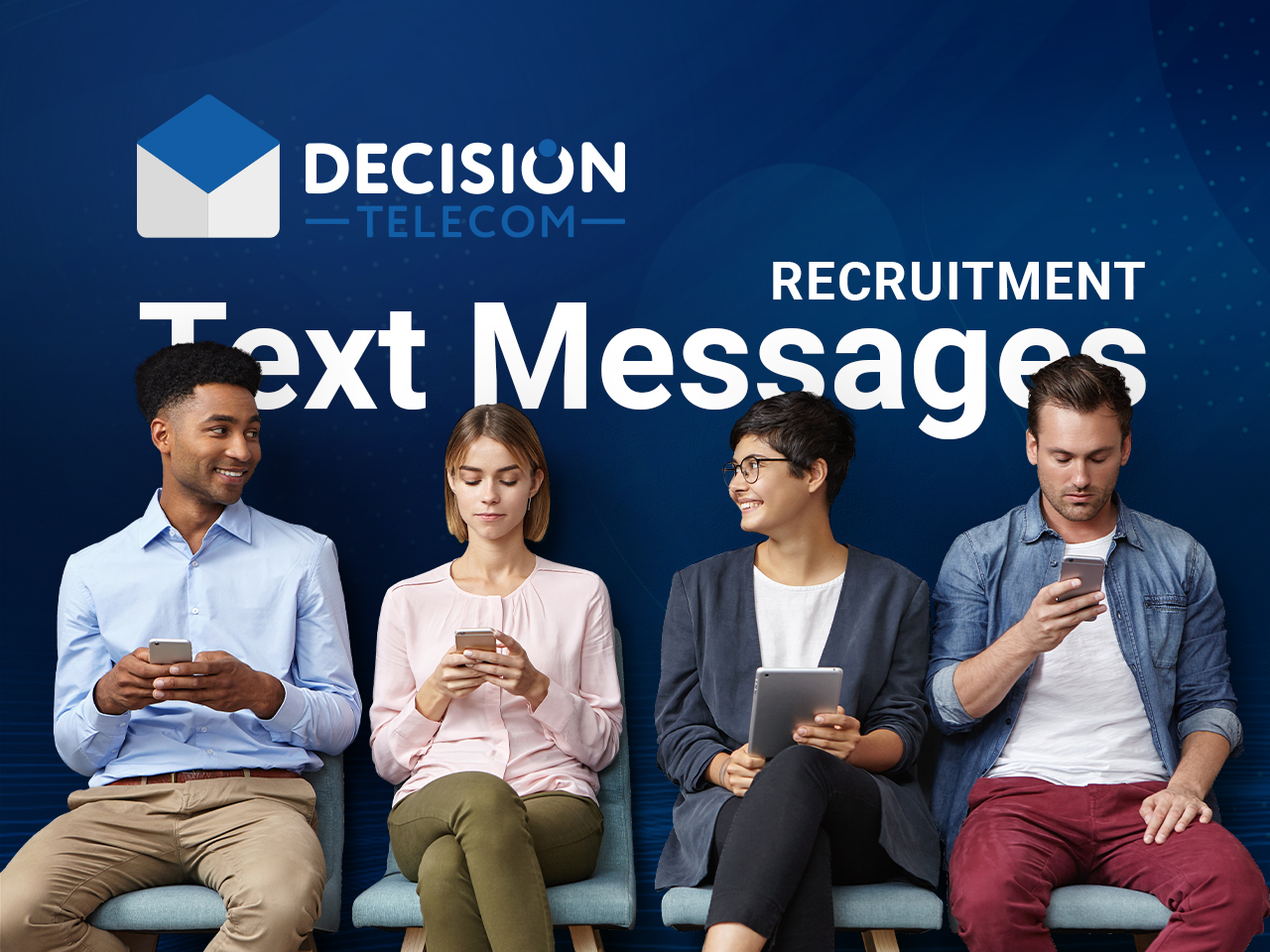
Recruitment Text Messages: How to Reach Top Talent in 2024
Recruiting top talent is crucial for any organization's success, yet traditional methods like email and job boards can often fall short. Emails might be ignored or missed entirely, job board postings can get buried under numerous listings, and standing out in a sea of applicants can be challenging. Younger generations, in particular, prefer quick and convenient communication directly on their phones. Enter text recruiting—an evergreen communication channel that can revolutionize the hiring process.
Text recruiting offers faster hiring, higher response rates, and a better overall recruitment experience for candidates. Efficient communication during the recruitment process is vital, and text recruiting ensures that you connect with candidates in a timely, effective manner.
What is Text Recruiting?
Text recruiting is the use of SMS or other messaging platforms to connect with job seekers and applicants. It leverages the convenience and immediacy of mobile communication to engage candidates quickly and efficiently. Recruiting texts can include job alerts, interview invites, updates on candidates’ job applications, onboarding messages, and more.
The method works because it capitalizes on the fact that nearly everyone has a mobile phone and checks their messages frequently. This immediacy allows recruiters to reach candidates in real-time, making the hiring process smoother and more responsive.
The Advantages of Text Recruiting

In today's fast-paced job market, finding efficient and effective ways to connect with potential candidates is more important than ever. Recruitment text has emerged as a powerful tool for recruiters, offering numerous benefits that can enhance the hiring process. From speed and efficiency to higher engagement rates, convenience, personal connection, and automation, text recruiting can transform how organizations attract and hire top talent. Let's explore the key advantages of recruitment text and how it can make a significant impact on your recruitment efforts.
Speed and Efficiency
One of the most significant benefits of text recruiting is its speed. Recruiters can get responses and schedule interviews within minutes, eliminating the days-long back-and-forth that often accompanies email exchanges.
This immediate response capability can significantly reduce the time-to-hire, which is crucial in a competitive job market where talent is snapped up quickly. The efficiency gained through text recruiting means that vacancies can be filled faster, minimizing disruptions to team productivity and business operations.
Higher Engagement Rates
Text messages boast an impressive open rate of up to 95%, significantly higher than email. This ensures that your messages are seen and responded to, increasing the likelihood of engaging with top talent. High open rates translate to higher response rates, meaning recruiters can connect with candidates more effectively.
This high engagement level is particularly important in the initial stages of recruitment when first impressions are crucial. Candidates are more likely to respond to a text message than an email, allowing recruiters to establish communication lines quickly.
Convenience
For HR personnel, text recruiting offers the convenience of reaching candidates anytime, anywhere, on the devices they use most. This flexibility can make the hiring process more manageable and efficient. Recruiters can send messages during their workday and candidates can respond at their convenience, creating a seamless communication flow.
Additionally, the ubiquitous nature of mobile phones means that candidates can receive and respond to messages regardless of their location, making text recruiting ideal for reaching out to passive candidates who may not be actively looking for new opportunities but are open to engaging with recruiters.
Personal Connection
Text messages are inherently more personal, helping to establish a strong rapport and foster a positive candidate experience. A personal touch can make candidates feel valued and more inclined to engage with your organization. This personal connection is crucial in building a positive employer brand and creating a favorable impression of the company.
By communicating in a medium that candidates are comfortable with, recruiters can build trust and rapport from the very beginning, leading to a more positive candidate experience. Furthermore, the informal nature of text messaging allows for a more conversational tone, making interactions feel less transactional and more genuine.
Automation
Using the right platforms, such as Decision Telecom’s SMS messaging service paired with your HRMS, you can automate repetitive tasks. This saves recruiters time and streamlines the recruitment process, making it more efficient. Automation can handle tasks such as sending out initial job alerts, scheduling interviews, and sending follow-up messages, freeing up recruiters to focus on more strategic activities.
Additionally, automated recruiting text message recruiting platforms can track responses and interactions, providing valuable data and insights to improve the hiring process. This automation not only enhances efficiency but also ensures consistency in communication, reducing the risk of human error.
Best Practices for Text Recruiting

Text recruiting can significantly enhance your hiring process by providing quick and effective communication with candidates. However, to maximize its benefits, it's important to follow best practices that ensure your messages are professional, engaging, and compliant with regulations. Implementing these strategies will not only improve your response rates and candidate experience but also help you build a strong employer brand. Here are some essential guidelines to help you make the most of text recruiting.
1. Get Permission First
Before sending recruiting texts, always ask for consent. Let candidates know during the application process that their contact number might be used for recruitment communication. This not only respects their privacy but also ensures compliance with regulations like the TCPA and GDPR.
Always offer an opt-out option so candidates can stop receiving messages if they choose. Getting permission isn’t just about following the law; it’s about respecting candidates' privacy and preferences. Being transparent about your communication methods helps build trust with potential candidates right from the start.
2. Craft Effective, Compelling Messages
Crafting effective and compelling messages is crucial in text recruiting, given the 160-character limit of SMS messages. To achieve this, follow these key points:
- Start with a strong opening: Introduce yourself and your organization to set the context and grab the candidate’s attention.
Example: "Hi [Candidate Name], this is [Your Name] from [Company Name]."
- Highlight key information immediately: Focus on the most important aspects of the job or role and any special perks.
Example: "We have an exciting [Job Title] position with flexible hours and great benefits."
- State your purpose upfront: Clearly explain why you're reaching out, whether it's to invite them to an interview, alert them about a job opportunity, or provide an update on their application.
- Include clear response instructions: Guide the candidate on how they can respond. If they can't reply via text, provide an alternative, such as a shortened link or an email address.
- Maintain a friendly yet professional tone: Ensure your message is concise, engaging, and easy to read.
By focusing on these elements, you can create messages that are informative, engaging, and effective in driving candidate responses.
3. Time Your Text Messages Right
When it comes to recruiting via text, timing is everything. Sending messages at the right time shows respect for candidates and enhances your organization's professionalism.
Here are some key points to keep in mind:
Send texts during business hours
- Avoid early mornings or late nights to ensure professionalism and respect for candidates' personal time.
Consider local time zones
- If you are recruiting across different regions, take into account candidates' local time zones to ensure your messages are received at appropriate times.
- Proper timing is crucial for your messages to be received positively. Texting outside of business hours can be seen as intrusive and unprofessional.
Respecting candidates' time
- By sending texts at appropriate times, you demonstrate that your organization values work-life balance and considers the well-being of its employees. This approach helps build a positive image of your company.
4. Use Templates (But Customize Them)
Templates provide a reliable framework for your messages, ensuring that important information is conveyed clearly and professionally. Here's how to effectively leverage templates in your recruitment process:
Use Existing SMS Templates
Utilize SMS templates for common messages like job alerts, interview invites, and introductions. Templates can save time and ensure consistency across your communications.
Personalize Your Messages
Personalize your messages by mentioning the candidate’s name and specifics from their resume or application. Customizing your messages helps you stand out and makes candidates feel valued.
Follow Branding Guidelines
Customizing your messages according to your company's branding guidelines is important. This helps maintain a consistent brand image and reinforces your organization's identity.
The Importance of Personalization
While templates are efficient, personalization is key to making candidates feel valued. By tailoring your messages to individual candidates, you demonstrate that you have reviewed their application and are genuinely interested in them as potential employees.
5. Automate, But Humanize It
Use SMS software to schedule texts and track responses, but don’t rely solely on automation. This helps manage routine tasks efficiently.
Be prepared to have real conversations and respond promptly to candidates’ questions.
Quick responses show professionalism and seriousness about your recruitment efforts.
Automation can handle routine tasks, but human interaction is essential for building relationships. By combining automation with a personal touch, you can create a seamless and engaging candidate experience.
Responding promptly to candidate inquiries shows that you are attentive and responsive, which can significantly enhance the candidate's perception of your organization.
6. Segment Your Audience
Effective recruitment communication requires tailoring your messages to different candidate segments. Here are some key strategies to ensure your messages resonate with your target audience:
- Adapt Messages for Different Levels
Customize your messages for entry-level versus senior candidates. - Send Targeted Invitations
For example, invite fresh graduates to job fairs specifically designed for them. - Highlight Specific Qualifications
Mention specific qualifications from candidates' resumes to show that you have thoroughly reviewed their applications. - Tailor Your Messaging
Segmentation allows you to tailor your messaging to different groups, making your communication more relevant and effective. - Understand Unique Needs
By understanding the unique needs and preferences of different candidate segments, you can craft messages that resonate with them.
Tailored messages are more likely to elicit positive responses from candidates, enhancing the effectiveness of your recruitment efforts.
7. Leverage Texting for Onboarding
Using text messages for onboarding can greatly enhance the new hire experience by providing timely and relevant information.
- Send welcome messages and onboarding instructions to new hires to make them feel valued.
- Keep new employees engaged and informed by sending text reminders for important dates and deadlines.
- Improve your onboarding process by collecting feedback through quick SMS surveys.
Onboarding is a critical phase in the employee lifecycle, and effective communication during this period sets the tone for the employee's entire experience with your organization. By using text messaging to deliver timely and relevant information, you can ensure that new hires feel supported and well-prepared for their new role.
8. Integrate with Your ATS
Here’s a step-by-step guide to help you make this integration of your recruitment text platform with your Applicant Tracking System (ATS):
Step 1: Connect Your Systems
Connect your recruitment text platform with your Applicant Tracking System (ATS) or HRMS. This will streamline communication and track candidate progress efficiently.
Step 2: Automate Updates
Set up your system to automatically update candidate records based on text interactions. This ensures peak efficiency and accurate record-keeping.
Step 3: Manage Interactions in One Place
Use the integration to manage all candidate interactions in one centralized location. This provides a seamless and efficient hiring process.
Step 4: Ensure No Communication is Lost
Integration ensures that no communication is lost and all candidate data is up-to-date, giving you a comprehensive view of each candidate's journey through the recruitment process.
Step 5: Monitor and Improve
Continuously monitor the integrated system to identify areas for improvement and ensure that the hiring process remains efficient and effective.
9. Track Your Results
Tracking your results is essential for understanding the effectiveness of your text recruiting efforts. By analyzing key metrics, you can identify areas for improvement and make data-driven decisions to optimize your recruitment strategy.
Key Metrics to Analyze and Track:
Open Rates: Measure the percentage of candidates who open your recruitment texts. This helps you understand the effectiveness of your subject lines and initial message content.
Response Rates: Track the percentage of candidates who respond to your texts. This indicates how engaging and relevant your messages are to the recipients.
Time-to-Hire: Monitor the duration it takes from initial contact to the candidate's hiring. This metric helps assess the efficiency of your recruitment process.
Conversion Rates: Calculate the percentage of candidates who progress from one stage of the recruitment process to the next, ultimately leading to a hire.
Opt-Out Rates: Keep an eye on the number of candidates opting out of receiving further messages. High opt-out rates may indicate issues with message frequency or content relevance.
Engagement Rates: Evaluate the overall interaction level with your messages, including clicks on links or calls to action.
By consistently monitoring and analyzing these key metrics, you can gain valuable insights into your text recruiting efforts. This data-driven approach allows you to refine your strategies, improve candidate engagement, and enhance the overall efficiency of your recruitment process. Continuous improvement is crucial for staying competitive in the ever-evolving recruitment landscape.
Text Message Templates for Different Stages of the Hiring Process

Sourcing
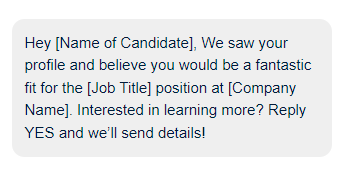
This message is concise and to the point, capturing the candidate's interest by highlighting a potential job fit. It also includes a clear call to action, prompting the candidate to respond if they are interested.

This message provides more specific information about the next job opening and includes a link to the job details, making it easy for the candidate to learn more and decide if they want to proceed.
Screening
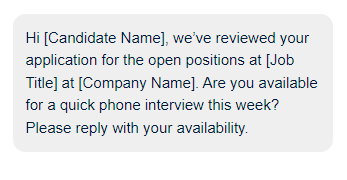
This message clearly communicates the purpose of the communication and asks for the candidate's availability, facilitating the scheduling process.

This message is polite and professional, expressing gratitude for the candidate's application and requesting their availability for an interview.
Interviewing
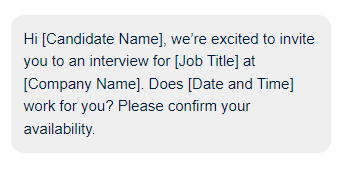
This message expresses enthusiasm for the candidate's upcoming interview, and asks for their availability, making it easy for the candidate to confirm or suggest an alternative time.
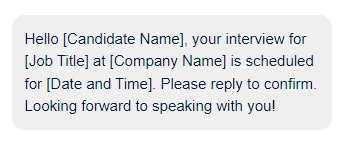
This message provides specific details about the interview and asks for confirmation, ensuring that the candidate has all the necessary information and can confirm their attendance.
Offer
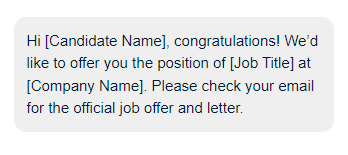
This message congratulates the candidate and directs them to their email for the official offer letter, making it clear and easy for the candidate to take the next steps.
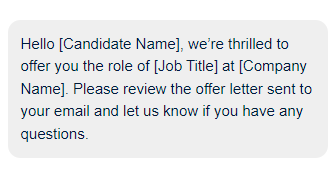
This message expresses excitement about the offer and provides clear instructions for the candidate to review the offer letter and ask any questions they may have.
Onboarding
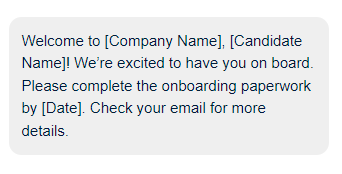
This message warmly welcomes the new hire and provides specific instructions for completing onboarding paperwork, ensuring that the new hire knows what to do next.
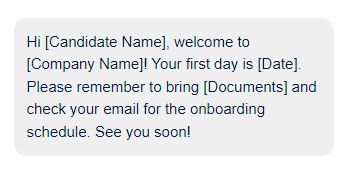
This message provides essential information about the new hire's first day job search, and the documents they need to bring, helping them feel prepared and supported as they start their new role.
Conclusion
Text recruiting is a powerful tool that can transform your recruitment process by enhancing efficiency, engagement, and the overall candidate experience. By leveraging the immediacy and convenience of mobile communication, you can connect with candidates quickly and effectively. The key to successful text recruiting lies in following best practices, continuously refining your strategy based on feedback and data, and integrating it seamlessly into your overall recruitment process.
To get started with text recruiting, consider using Decision Telecom’s SMS service. With the right approach and tools, you can revolutionize your hiring process, attract top talent, and build a strong employer brand. Embrace the future of recruitment with text messaging and unlock new possibilities for your organization’s growth and success.
In conclusion, with the right approach and tools, you can revolutionize your hiring process, attract top talent, and build a strong employer brand. Embrace the future of recruitment with text messaging and unlock new possibilities for your organization’s growth and success. By integrating text recruiting into your overall strategy, you can ensure that your hiring process is not only more efficient but also more personal and effective, leading to better outcomes for your organization.


